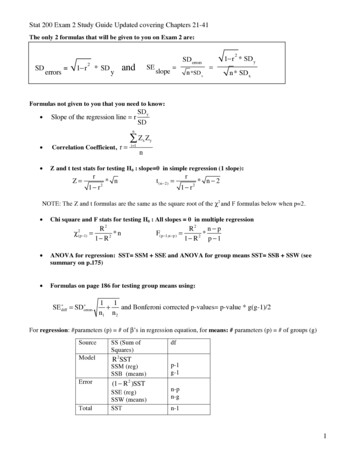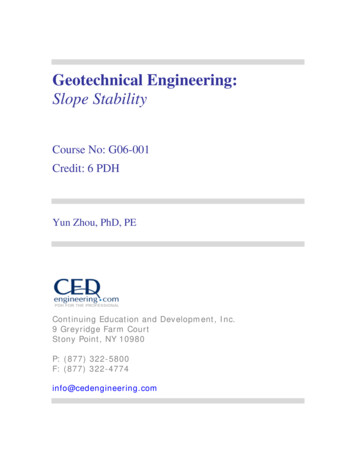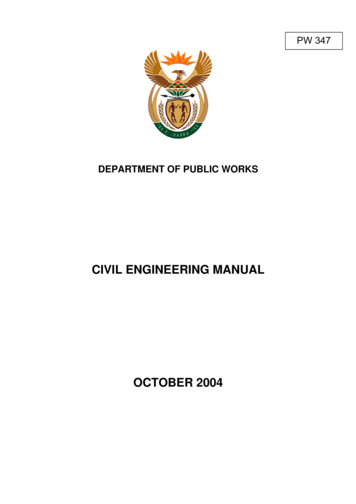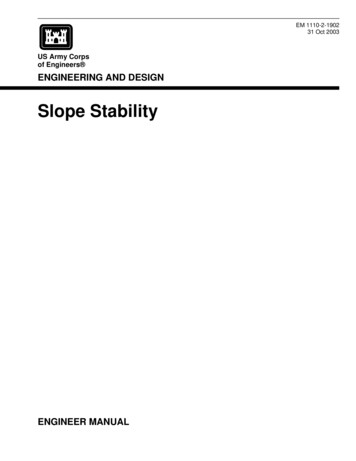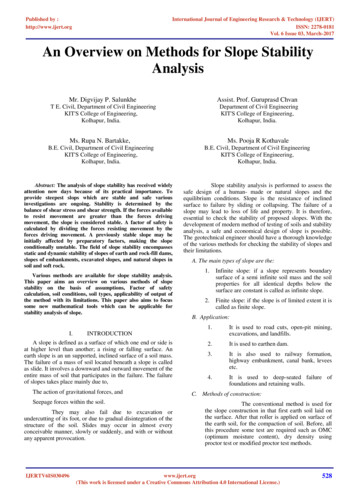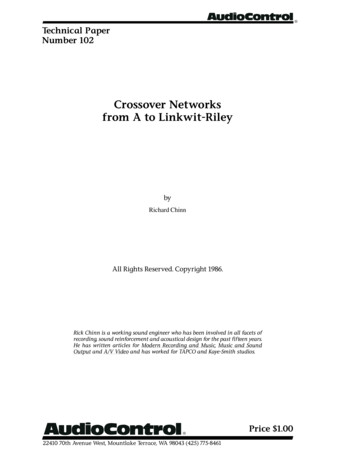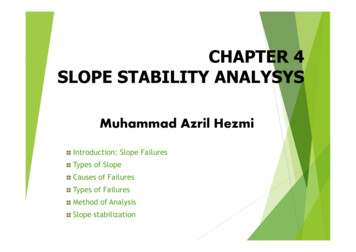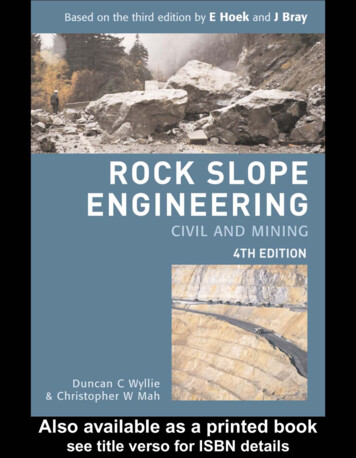
Transcription
Rock Slope Engineering
Rock Slope EngineeringCivil and mining4th editionDuncan C. Wyllie andChristopher W. Mah
First published 1974 by the Institute of Mining and MetallurgySecond edition published 1977Third edition published 1981 The Institute of Mining and Metallurgy and E. Hoek and J. W. Bray2 Park Square, Milton Park, Abingdon, Oxon, OX14 4RNSimultaneously published in the USA and Canadaby Spon Press270 Madison Avenue, New York, NY 10016This edition published in the Taylor & Francis e-Library, 2005.“To purchase your own copy of this or any of Taylor & Francis or Routledge’scollection of thousands of eBooks please go to www.eBookstore.tandf.co.uk.”Spon Press is an imprint of the Taylor & Francis Group 2004 Duncan C. Wyllie and Christopher W. MahAll rights reserved. No part of this book may be reprinted orreproduced or utilised in any form or by any electronic,mechanical, or other means, now known or hereafterinvented, including photocopying and recording, or in anyinformation storage or retrieval system, without permission inwriting from the publishers.British Library Cataloguing in Publication DataA catalogue record for this book is available from the British LibraryLibrary of Congress Cataloging in Publication DataRock slope engineering : civil and mining / Duncan C. Wyllie,Christopher W. Mah — 4th ed.p. cm.“Based on Rock Slope Engineering (third edition, 1981) byDr Evert Hoek and Dr John Bray.”1. Rock slopes. I. Mah, Christopher W. II. Wyllie, Duncan C.,1933 — Rock slope engineering. III. Title.TA706.W98 2004624.1 51363–dc22ISBN 0-203-49908-5 Master e-book ISBNISBN 0-203-57083-9 (Adobe eReader Format)ISBN 0–415–28000–1 (hbk)ISBN 0–415–28001–X (pbk)2003014937
This book is dedicated toDr Evert Hoek and Dr John Brayin recognition of their pioneering work in the field of rock slope engineering.
s of rock slope design1.11.21.31.421Introduction 11.1.1Scope of book 21.1.2Socioeconomic consequences of slope failures 3Principles of rock slope engineering 41.2.1Civil engineering 41.2.2Open pit mining slope stability 5Slope features and dimensions 8Rock slope design methods 81.4.1Summary of design methods 81.4.2Limit equilibrium analysis (deterministic) 111.4.3Sensitivity analysis 141.4.4Probabilistic design methods 151.4.5Load and Resistance Factor Design 20Structural geology and data tives of geological investigations 22Mechanism of joint formation 24Effects of discontinuities on slope stability 25Orientation of discontinuities 25Stereographic analysis of structural geology 272.5.1Stereographic projection 272.5.2Pole plots and contour plots 292.5.3Pole density 3122
viiiContents2.62.72.83Site investigation and geological data collection3.13.23.33.43.53.642.5.4Great circles 322.5.5Lines of intersection 34Identification of modes of slope instability 352.6.1Kinematic analysis 372.6.2Plane failure 382.6.3Wedge failure 382.6.4Toppling failure 392.6.5Friction cone 392.6.6Applications of kinematic analysis 40Example Problem 2.1: stereo plots of structural geology data 43Example Problem 2.2: slope stability evaluation related to structural geology 44Planning an investigation program 463.1.1Geology 473.1.2Rock strength 483.1.3Ground water 48Site reconnaissance 483.2.1Aerial and terrestrial photography 493.2.2Geophysics 49Geologic mapping 523.3.1Line and window mapping 533.3.2Stereogrammetric mapping of discontinuities 533.3.3Types of discontinuity 533.3.4Definition of geological terms 54Spacing, persistence and roughness measurements 593.4.1Spacing of discontinuities 603.4.2Persistence of discontinuity sets 613.4.3Roughness of rock surfaces 62Probabilistic analysis of structural geology 643.5.1Discontinuity orientation 643.5.2Discontinuity length and spacing 65Diamond drilling 673.6.1Diamond drilling equipment 673.6.2Diamond drilling operations 683.6.3Core logging 693.6.4Core orientation 71Rock strength properties and their measurement4.146Introduction 744.1.1Scale effects and rock strength 7474
Contents4.24.34.44.54.64.74.854.1.2Examples of rock masses 754.1.3Classes of rock strength 77Shear strength of discontinuities 794.2.1Definition of cohesion and friction 794.2.2Friction angle of rock surfaces 814.2.3Shearing on an inclined plane 814.2.4Surface roughness 824.2.5Discontinuity infilling 854.2.6Influence of water on shear strength of discontinuities 88Laboratory testing of shear strength 88Shear strength of rock masses by back analysis of slope failures 90Hoek–Brown strength criterion for fractured rock masses 924.5.1Generalized Hoek–Brown strength criterion 954.5.2Modulus of deformation 994.5.3Mohr–Coulomb criterion 994.5.4Rock mass strength 1004.5.5Determination of σ3 max 1004.5.6Estimation of disturbance factor D 101Rock durability and compressive strength 1024.6.1Slake durability 1024.6.2Compressive strength 104Example Problem 4.1: analysis of direct shear strength test results 106Example Problem 4.2: analysis of point load test results 107Ground water5.15.25.35.45.55.6ixIntroduction 109The hydrologic cycle 110Hydraulic conductivity and flow nets 1115.3.1Hydraulic conductivity 1115.3.2Porosity 1135.3.3Flow nets 113Ground water flow in fractured rock 1145.4.1Flow in clean, smooth discontinuities 1155.4.2Flow in filled discontinuities 1165.4.3Heterogeneous rock 1175.4.4Anisotropic rock 1185.4.5Ground water in rock slopes 118Measurement of water pressure 120Field measurement of hydraulic conductivity 1235.6.1Variable head tests 1245.6.2Pumping test 126109
xContents5.76Plane failure6.16.26.36.46.56.66.777.6153Introduction 153Definition of wedge geometry 154Analysis of wedge failure 156Wedge analysis including cohesion, friction and water pressure 157Wedge stability charts for friction only 1607.5.1Example of wedge analysis using friction-only charts 170Comprehensive wedge analysis 1717.6.1Data for comprehensive analysis 1717.6.2Computer programs for comprehensive analysis 1747.6.3Example of comprehensive wedge analysis 175Circular failure8.1129Introduction 129General conditions for plane failure 129Plane failure analysis 1296.3.1Influence of ground water on stability 1336.3.2Critical tension crack depth and location 1346.3.3The tension crack as an indicator of instability 1346.3.4Critical slide plane inclination 1366.3.5Analysis of failure on a rough plane 137Reinforcement of a slope 1386.4.1Reinforcement with tensioned anchors 1386.4.2Reinforcement with fully grouted untensioned dowels 1396.4.3Reinforcement with buttresses 140Seismic analysis of rock slopes 1416.5.1Performance of rock slopes during earthquakes 1416.5.2Seismic hazard analysis 1426.5.3Ground motion characterization 1436.5.4Pseudo-static stability analysis 1446.5.5Newmark analysis 145Example of probabilistic design 148Example Problem 6.1: plane failure—analysis and stabilization 150Wedge failure7.17.27.37.47.58Example Problem 5.1: Influence of geology and weather conditions onground water levels 127Introduction 176176
Contents8.28.38.48.58.68.79Conditions for circular failure and methods of analysis 1768.2.1Shape of slide surface 1778.2.2Stability analysis procedure 178Derivation of circular failure charts 1808.3.1Ground water flow assumptions 1808.3.2Production of circular failure charts 1818.3.3Use of the circular failure charts 182Location of critical slide surface and tension crack 184Examples of circular failure analysis 1858.5.1Example 1—China clay pit slope 1858.5.2Example 2—highway slope 186Detailed stability analysis of circular failures 1878.6.1Bishop’s and Janbu’s method of slices 1888.6.2Use of non-linear failure criterionin Bishop stability analysis 1938.6.3Example of Bishop’s and Janbu’s methods of analysis 1938.6.4Circular failure stability analysis computer programs 1958.6.5Three-dimensional circular failure analysis 1968.6.6Numerical slope stability analysis 196Example Problem 8.1: circular failure analysis 197Toppling failure9.19.29.39.4xiIntroduction 200Types of toppling failure 2009.2.1Block toppling 2009.2.2Flexural toppling 2019.2.3Block-flexure toppling 2029.2.4Secondary toppling modes 202Kinematics of block toppling failure 2049.3.1Block shape test 2049.3.2Inter-layer slip test 2049.3.3Block alignment test 205Limit equilibrium analysis of toppling on a stepped base 2059.4.1Block geometry 2069.4.2Block stability 2089.4.3Calculation procedure for toppling stabilityof a system of blocks 2109.4.4Cable force required to stabilize a slope 2109.4.5Factor of safety for limiting equilibrium analysisof toppling failures 2119.4.6Example of limit equilibrium analysis of toppling 2119.4.7Application of external forces to toppling slopes 213200
xiiContents9.59.6Stability analysis of flexural toppling 214Example Problem 9.1: toppling failure analysis 21610 Numerical analysis21810.1 Introduction 21810.2 Numerical models 22010.2.1Joint material models 22110.2.2Rock mass material models 22110.3 Modeling issues 22310.3.1Two-dimensional analysis versus three-dimensional analysis 22310.3.2Continuum versus discontinuum models 22510.3.3Selecting appropriate zone size 22610.3.4Initial conditions 22610.3.5Boundary conditions 22810.3.6Incorporating water pressure 22910.3.7Excavation sequence 23010.3.8Interpretation of results 23010.4 Typical stability analysis 23110.4.1Rock mass failure 23110.4.2Plane failure—daylighting and non-daylighting 23310.4.3Wedge failure—daylighting and non-daylighting 23410.4.4Toppling failure—block and flexural 23410.4.5Flexural buckling failure 23710.5 Special topics 23710.5.1Reinforcement 23710.5.2Time-dependent behavior 23910.5.3Dynamic analysis 24411 Blasting11.1 Introduction 24511.2 Mechanism of rock fracturing by explosives 24611.3 Production blasting 24711.3.1Explosive properties 24811.3.2Bench height 24911.3.3Burden 25011.3.4Blast hole diameter 25111.3.5Nature of the rock 25111.3.6Sub-drill depth 25211.3.7Stemming 25211.3.8Hole spacing 253245
Contents11.411.511.611.711.8xiii11.3.9Hole detonation sequence 25311.3.10 Fragmentation 25511.3.11 Evaluation of a blast 256Controlled blasting to improve stability 25711.4.1Pre-shearing and cushion blasting 25711.4.2Drilling 25911.4.3Explosive load 25911.4.4Stemming 26011.4.5Spacing and burden 26111.4.6Hole detonation sequence 261Blast damage and its control 26211.5.1Damage from ground vibration 26211.5.2Control of flyrock 27011.5.3Control of air blast and noise 270Example Problem 11.1: blast design 273Example Problem 11.2: controlled blasting design 274Example Problem 11.3: blast damage control 27512 Stabilization of rock slopes12.1 Introduction 27612.2 Causes of rock falls 27712.3 Rock slope stabilization programs 27912.3.1Planning stabilization programs 27912.3.2Rock slope inventory systems 27912.3.3Hazard rating criteria 28012.3.4Database analysis of slope inventory 28212.3.5Selection of high priority sites 28212.3.6Selection of stabilization measures 28312.4 Stabilization by rock reinforcement 28612.4.1Shear keys 28712.4.2Rock anchors 28712.4.3Reaction wall 30112.4.4Shotcrete 30112.4.5Buttresses 30412.4.6Drainage 30412.4.7“Shot-in-place” buttress 30612.5 Stabilization by rock removal 30712.5.1Resloping and unloading 30812.5.2Trimming 30812.5.3Scaling 30812.5.4Rock removal operations 30912.6 Protection measures against rock falls 309276
6.7Rock fall modeling 310Ditches 312Barriers 313Rock catch fences and attenuators 316Draped mesh 317Warning fences 317Rock sheds and tunnels 31813 Movement monitoring32013.1 Introduction 32013.2 Types of slope movement 32213.2.1Initial response 32213.2.2Regressive and progressive movement 32213.2.3Long-term creep 32413.3 Surface monitoring methods 32413.3.1Crack width monitors 32513.3.2Surveying 32613.3.3Laser imaging 32713.3.4Tiltmeters 32713.3.5Global positioning system 32713.3.6Synthetic aperture radar 32713.4 Sub-surface monitoring methods 32713.4.1Borehole probes 32813.4.2Time–domain reflectometry 32813.4.3Inclinometers 32813.5 Data interpretation 32813.5.1Time–movement and time–velocity plots 32913.5.2Slope failure mechanisms 33214 Civil engineering applications14.1 Introduction 33414.2 Case Study I—Hong Kong: choice of remedial measures for plane failure 33414.2.1Site description 33414.2.2Geology 33414.2.3Rock shear strength 33514.2.4Ground water 33514.2.5Stability analysis 33514.2.6Stabilization options 33914.3 Case Study II—Cable anchoring of plane failure 34114.3.1Site description 341334
Contentsxv14.3.2Geology 34214.3.3Rock shear strength 34214.3.4Ground water 34314.3.5Earthquakes 34414.3.6Stability analysis 34414.3.7Stabilization method 34514.3.8Construction issues 34714.4 Case Study III—Stability of wedge in bridge abutment 34814.4.1Site description 34814.4.2Geology 34814.4.3Rock strength 34914.4.4Ground water 34914.4.5Seismicity 35014.4.6External forces 35014.4.7Stability analysis 35014.5 Case Study IV—Circular failure analysis of excavation for rock fall ditch 35214.5.1Site description 35214.5.2Geology 35314.5.3Ground water 35314.5.4Rock shear strength 35314.5.5Ditch and slope design 35414.5.6Construction issues 35414.6 Case Study V—Stabilization of toppling failure 35414.6.1Site description 35414.6.2Geology 35514.6.3Rock strength 35514.6.4Ground water 35514.6.5Stability conditions 35514.6.6Stabilization method 35615 Mining applications15.1 Introduction 35715.2 Example 1—porphyry deposits 35715.2.1Design issues 35815.2.2Engineering geology 35815.2.3Rock strength and competency 35815.2.4Hydrogeology 35915.2.5Slope stability analyses and slope design 35915.3 Example 2—stratigraphically controlled deposits 36115.3.1Design issues 36115.3.2Engineering geology 36115.3.3Rock strength and competency 362357
xviContents15.3.4Hydrogeology 36315.3.5Structural domains 36315.3.6Kinematic analyses 36315.3.7Stability analyses 36415.3.8Slope design concepts 36515.3.9Preliminary design 36715.4 Example 3—deep-seated deformation in a weak rock mass 36815.4.1Design and operational issues 36815.4.2Engineering geology 36915.4.3Rock strength and rock mass competency 37015.4.4Hydrogeology and slope depressurization measures 37015.4.5Slope stability analyses 37115.4.6Slope design and operational management 37215.5 Example 4—overall slope design in a competent rock mass 37215.5.1Design aspects and issues 37215.5.2Engineering geology 37315.5.3Rock strength and competency 37315.5.4Hydrogeology 37315.5.5Slope performance 37415.5.6Slope stability analyses 37515.5.7Implementation and ongoing evaluation 37515.6 Conclusions 376Appendix II.1I.2I.3I.4I.5II.3377Introduction 377Plotting poles 377Contouring pole concentrations 377Plotting great circles 377Lines of intersection 378Appendix IIII.1II.2Stereonets for hand plotting of structural geology dataQuantitative description of discontinuities in rock massesIntroduction 381Rock mass characterization parameters 381II.2.1Rock material description 381II.2.2Discontinuity description 383II.2.3Infilling description 389II.2.4Rock mass description 389II.2.5Ground water 392Field mapping sheets 394381
ContentsAppendix IIIIII.1III.2III.3III.4III.5III.6Comprehensive solution wedge stabilityxvii398Introduction 398Analysis methods 398Analysis limitations 399Scope of solution 399Notation 400Sequence of calculations 400Appendix IVReferencesIndexConversion factors408411425
IntroductionReaders will undoubtedly recognize the similarity of this book to Rock Slope Engineering by Dr EvertHoek and Dr John Bray. We hope the following discussion of the origin and evolution of the currentbook will help to demonstrate the relationship between the two.Rock Slope Engineering was published in three editions (1974, 1977 and 1981) by the Institute ofMining and Metallurgy in London. The original research for the book at the University of Londonwas sponsored by the mining industry in response to a need to develop design methods for increasingly deep open pits. The 1960s and 1970s had seen the development of a new generation of highproduction drills, shovels and trucks that made low grade ore deposits economical to mine, and therewas a consequent significant increase in the size of open pits. The investigation and design techniquesoriginally developed in Rock Slope Engineering for mines were soon adopted in civil engineeringwhere the slopes’ heights are usually less than those in open pits, but there is a need for a high level ofreliability in terms of both rock falls and overall stability. In response to the demand for a book thatclearly presents well-proven methods to design rock slopes, Hoek and Bray’s book has continued tosell steadily around the world, and has been translated into a number of languages.In 1980, one of the authors of this book (DCW) was awarded a contract by the Federal HighwayAdministration (FHWA) in Washington to prepare a manual on rock slope design and constructionspecifically applicable to highways. At that time, I was working with Dr Hoek and he generously agreedthat his manuscript of Rock Slope Engineering could be adapted for this purpose. The manual closelyfollowed the original book, apart from chapters on slope stabilization and movement monitoring.A second FHWA contract was awarded in 1996 as part of an eleven module series on highwaygeotechnical engineering, and this opportunity was taken to embark on a major updating of themanual. The manuals have been used primarily as teaching material for a series of courses sponsoredby the National Highway Institute for highway engineers in the United States; to date over 40 courseshave been presented.It was realized that a limitation of the FHWA manuals was their focus on highway engineering, andthat their availability was generally limited to course participants. Therefore, in 2001 it was decidedthat it would be worthwhile to produce another update that would cover the wider field of rock slopeengineering, including civil and mining applications. In order to take this step, it was necessary toobtain the permission and co-operation of a number of organizations and individuals—Mr JerryDiMaggio of the Federal Highway Administration, Dr G. P. Jayaprakash of the TransportationResearch Board, both in Washington, and Dr George Munfakh of Parsons Brinckerhoff Quade andDouglas (PBQD) in New York. We are most grateful for their assistance and encouragement.Of course, the most important participant in this work has been Dr Evert Hoek who generouslyagreed that we could use Rock Slope Engineering as the basis for the new work. Since Dr Hoeklives in the same neighborhood, it has been possible to have a series of meetings to discuss both the
Introductionxixoverall approach and details of the contents and methods. We express our gratitude for the valuableassistance that we have received from Dr Hoek over the two years, as well as his pioneering workwith Dr Bray in establishing the fundamental procedures for rock slope engineering.Dr Lorin Lorig and Mr Pedro Varona of Itasca Corporation and Mr Alan Stewart and his colleaguesat Piteau Associates Engineering have also made important contributions. Dr Lorig and Mr Varonawrote Chapter 10 on numerical analysis methods, and the personnel from Piteau wrote Chapter 15 oncase studies on open pit mining. We decided these two chapters were best written by persons workingin these specialist fields, and we appreciate their hard work and dedication.One of our objectives in writing this book has been to maintain much of the original content of RockSlope Engineering, because the basic slope design methods that were developed for the 1974 editionare still valid to this day. Our approach has been to incorporate, within the original framework,technical advances and experience in rock slope design and construction projects over the past 30years. This has allowed us to maintain the structure of Rock Slope Engineering so that those who arefamiliar with Hoek and Bray can readily find their way around this book. In addition to generallyupdating the book, the following is a list of the major topics that have been added: Geological data collection—The International Society of Rock Mechanics nomenclature forstructural geology is included in Chapter 3 and Appendix II. Rock mass strength—The 2002 version of the Hoek–Brown rock mass strength criterion is includedin Chapter 4. Earthquakes—The effects of earthquakes on slope stability and design methods for slopes in seismicareas are described in Chapter 6. Probabilistic, and Load and Resistance Factor design methods—The basic principles of probabilistic and LRFD design are discussed in Chapter 1; an example of probabilistic design is includedin Chapter 6. Numerical analysis—Chapter 10 is a new chapter describing the use of numerical analysis methodsin slope design. Production blasting—Updated methods of designing production blasts have been added toChapter 11, which covers in addition, blasting methods for final walls and control of damageoutside the blast area. Slope stabilization and rock fall protection—Chapter 12 is a new chapter describing rock slopehazard assessment, slope reinforcement and rock fall protection such as ditches, fences and sheds. Slope movement monitoring—Surface and sub-surface movement monitoring methods, and datainterpretation are described in Chapter 13. Case studies in civil engineering—Case studies of plane, wedge, circular and toppling failures aredescribed in Chapter 14. Case studies in open pit mining—Four case studies demonstrating pit slope design in a variety ofgeologic environments are described in Chapter 15.It may be noticed that some material is very similar to that in the books Foundations on Rock and Landslides: Investigation and Stabilization. This duplication is inevitable when discussing fundamentals ofrock mechanics that do not change significantly over time.We would like to express our gratitude to a number of people, in addition to Dr Hoek who haveassisted us with this work. In particular, Ms Sonia Skermer and Mr George Gorczynski preparedthe illustrations, and Ms Glenda Gurtina prepared the original FHWA manual and has worked onmany of the complex portions of the text. We also appreciate the valuable input on seismic design byDr Randy Jibson and Dr Upul Atukorala, the photographs supplied by Rio Tinto Ltd and acknowledge
xxIntroductionour long associations with the Federal Highway Administration in Washington DC, the CanadianPacific Railway, and the British Columbia Ministry of Transportation.Finally, we are most grateful to our colleagues, fellow geotechnical engineers and contractors withwhom we have worked over many years on a wide range of projects. This book attempts to distillour collectively acquired experience.Duncan C. Wylliewww.wnrockeng.comChristopher W. Mahwww.cmrockeng.comVancouver, Canada, 2003
ForewordMy work on rock slope engineering started more than thirty years ago while I was Professor ofRock Mechanics at the Imperial College of Science and Technology in London, England. A four-yearresearch project on this topic was sponsored by 23 mining companies around the world, and wasmotivated by the need to develop design methods for the rock slopes in large open pit mines whichwere becoming increasingly important in the exploitation of low-grade mineral deposits. Rock SlopeEngineering, co-authored with my colleague Dr John Bray, was first published in 1974 and thenrevised in 1977 and again in 1981.While rock slope engineering remains an important subject, my own interests have shifted towardstunnelling and underground excavations. Consequently, when Duncan Wyllie suggested that he andChristopher Mah were willing to prepare a new book on rock slopes I felt that this would be anexcellent move. They have had a long involvement in practical rock slope engineering, mainly for civilengineering construction projects, and are familiar with recent developments in methods of analysisand stabilization. The evolution of their text, from Rock Slope Engineering to a manual on rock slopedesign for the US Federal Highway Administration, is described in their introduction and need not berepeated here.The text that follows is a comprehensive reference work on all aspects of rock slope engineeringand, while it embodies all the original concepts of my work, it expands on these and introduces asignificant amount of new material, for both mining and civil engineering and several new case studies.As such, I believe that it will be an important source of fundamental and practical information forboth students and designers for many years to come.I commend the authors for their efforts in producing this volume and I look forward to havinga copy on my own bookshelf.Evert HoekVancouver, 2003
Area of plane (m2 )Material constant for rock mass strength; ground acceleration (m/s2 )Burden distance for blast holes (m)Distance of tension crack behind crest of face (m); joint spacing (m)Dispersion coefficientCohesion (kPa)Disturbance factor for rock mass strength; depth (m)Diameter (mm)Deformation modulus for rock massJoint aperture (mm)Shape factorFactor of safetyShear modulus (GPa)Geological Strength IndexAcceleration due to gravity (m/s2 )Height of slope, face (m)Water level head above datum (m)Roughness angle of asperities (degrees)Joint roughness coefficientBulk modulus (GPa); hydraulic conductivity (cm/s 1 ); corrosion service life constant (µm),rate of slope movement constantSeismic coefficient; attenuation constant for blast vibrationsLength of scan line, face, borehole (m)Persistence of discontinuity (m); unit vectorUnit vectorMaterial constant for rock mass strengthmaterial constant for intact rockNumber of joints, readingsUnit vector, number of toppling blocksProbabilityPressure (kPa)External load (kN)Resultant vector; hole radius (mm)radius of piezometer (mm)
NotationSSDsTtUVWXzzwαβ xδεφγµσσcmσciσ1 σ3 τψυxxiiiShape factor; spacing distance for blast holes (m)Standard deviationSpacing of discontinuity (m); material constant for rock mass strengthRock bolt tension force (kN)Time (s, yr)Uplift force on sliding plane due to water pressure (kN)Thrust force in tension crack due to water pressure (kN); velocity of seismic waves (m/s),velocity of slope movementWeight of sliding block (kN); explosive weight per delay (kg)Loss of element thickness, corrosion (µm)Depth of tension crack (m)Depth of water in tension crack (m)Dip direction of plane (degrees)Attenuation constant for blast vibrationsWidth of toppling slab, slice in circular failure (m)Displacement (mm)Coefficient of thermal expansion (per C)Friction angle (degrees)Unit weight (kN/m3 )Poisson’s ratioNormal stress (kPa)Compressive strength of rock mass (kPa)Compressive strength of intact rock (kPa)Major principal effective stress (kPa)Minor principal effective stress (kPa)Shear stress (kPa)Dip of plane (degrees)Viscosity of water (m2 /s)
NoteThe recommendations and procedures contained herein are intended as a general guide, and prior totheir use in connection with any design, report, specification or construction procedure, they shouldbe reviewed with regard to the full circumstances of such use. Accordingly, although every care hasbeen taken in the preparation of this book, no liability for negligence or otherwise can be acceptedby the authors or the publisher.
Chapter 1Principles of rock slope design1.1 IntroductionA variety of engineering activities requireexcavation of rock cuts. In civil engineering,projects include transportation systems such ashighways and railways, dams for power production and water supply, and industrial and urbandevelopment. In mining, open pits account for themajor portion of the world’s mineral production.The dimensions of open pits range from areas ofa few hectares and depths of less than 100 m, forsome high grade mineral deposits and quarries inurban areas, to areas of hundreds of hectares anddepths as great as 800 m, for low grade ore deposits. The overall slope angles for these pits rangefrom near vertical for shallow pits in good quality rock to flatter than 30 for those in very poorquality rock.Figure 1.1 shows two typical rock slopes.Figure 1.1(a) is a rock cut, with a face angleof about 60 , supported with tensioned anchorsincorporating reinforced concrete bearing padsabout 1 m2 that distribute the anchor load onthe face. The face is also covered with shotcreteto prevent weathering and loosening between thebolts. Water control measures include drain holesthrough the shotcrete and drainage channels onthe benches and down the face to collect surfacerun-off. The support is designed to both ensurelong-term stability of the overall slope, and minimize rock falls that could be a hazard to traffic.Figure 1.1(b) shows the Palabora open pit inSouth Africa that is 830 m deep and an overallslope angle of 45–50 ; this is one of the steepestand deepest pits in the world (Stewart et al., 2000).The upper part of the pit is accessed via a dualramp system, which reduces to a single ramp inthe lower part of the pit.In addition to these man-made excavations, inmountainous terrain the stability of natural rockslopes may also be of concern. For example, highways and railways located in river valleys may belocated below such slopes, or cut into the toe,which may be detrimental to stability. One ofthe factors that may influence the stability of natural rock slopes is the regional tectonic setting.Factors of safety may be only slightly greater thanunity where there is rapid uplift of the land massand corresponding down-cutting of the watercourses, together with earthquakes that loosenand displace the slope. Such conditions exist inseismically active areas such as the Pacific Rim,the Himalayas and central Asia.The required stability conditions of rock slopeswill vary depending on the type of project andthe consequence of failure. For example, for cutsabove a highway carrying high traffic volumesit will be important that the overall slope bestabl
1.2 Principles of rock slope engineering 4 1.2.1 Civil engineering 4 1.2.2 Open pit mining slope stability 5 1.3 Slope features and dimensions 8 1.4 Rock slope design methods 8 1.4.1 Summary of design methods 8 1.4.2 Limit equilibrium analysis (deterministic) 11 1.4.3 Sens
